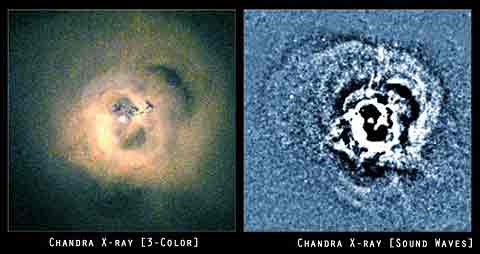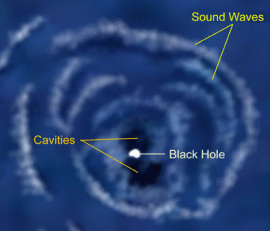|
Sound waves 57 octaves lower than middle-C
are rumbling away from a supermassive black hole in the Perseus
cluster.
by Ron Koczor
Astronomers using NASA's Chandra
X-ray Observatory have found, for the first time, sound waves from
a supermassive black hole. The "note" is the deepest ever detected
from any object in our Universe. The tremendous amounts of energy
carried by these sound waves may solve a longstanding problem in
astrophysics.
The black hole resides
in the Perseus cluster of galaxies located 250 million light years
from Earth. In 2002, astronomers obtained a deep Chandra observation
that shows ripples in the gas filling the cluster. These ripples
are evidence for sound waves that have travelled hundreds of thousands
of light years away from the cluster's central black hole.
Earlier observations had revealed
the prodigious amounts of light and heat created by black holes.
"Now we have detected their sound, too," says Andrew Fabian of the
Institute of Astronomy in Cambridge, England, and the leader of
the study.
In musical terms, the
pitch of the sound generated by the black hole translates into the
note of B flat. But, a human would have no chance of hearing this
cosmic performance because the note is 57 octaves lower than middle-C.
For comparison, a typical piano contains only about seven octaves.
At a frequency over a million billion times deeper than the limits
of human hearing, this is the deepest note ever detected from an
object in the Universe.
"The Perseus sound waves are much
more than just an interesting form of black hole acoustics," says
Steve Allen, also of the Institute of Astronomy and a co-investigator
in the research. "These sound waves may be the key in figuring out
how galaxy clusters, the largest structures in the Universe, grow."

more
Peering
into the heart of the Perseus Cluster (left), the Chandra
X-ray Observatory detected sound waves rippling through
the gas (right)
|
For years astronomers
have tried to understand why there is so much hot gas in galaxy
clusters and so little cool gas. Hot gas glowing with X-rays ought
to cool because X-rays carry away some of the gas' energy. Dense
gas near the cluster's centre where X-ray emission is brightest
should cool the fastest. As the gas cools, say researchers, the
pressure should drop, causing gas from further out to sink toward
the centre Trillions of stars ought to be forming in these gaseous
flows.
Yet scant evidence has been found
for flows of cool gas or for star formation. This forced astronomers
to invent several different ways to explain how gas contained in
clusters remained hot. None of them were satisfactory.
Black hole sound waves, however,
might do the trick.

more
An illustration
of cavities and sound waves in the hot gas filling the
Perseus cluster.
|
Previous Chandra observations of
the Perseus cluster reveal two vast, bubble-shaped cavities extending
away from the central black hole. These cavities have been formed
by jets
of material pushing back the cluster gas. The jets, which are
a counter-intuitive side effect of the black hole gobbling matter
in its vicinity, have long been suspected of heating the surrounding
gas. But the exact mechanism was unknown. The sound waves, seen
spreading out from the cavities in the recent Chandra observation,
could provide this heating mechanism.
A tremendous amount of energy is
needed to generate the cavities, as much as the combined energy
from 100 million supernovas. Much of this energy is carried by the
sound waves and should dissipate in the cluster gas, keeping the
gas warm and possibly preventing a cooling flow. If so, the B-flat
pitch of the sound wave, 57 octaves below middle-C, would have remained
roughly constant for about 2.5 billion years.
Perseus is the brightest cluster
of galaxies in X-rays, and therefore was a perfect Chandra target
for finding sound waves rippling through the hot cluster gas. Other
clusters show X-ray cavities, and future Chandra observations may
yet detect sound waves in those clusters, too.
|
